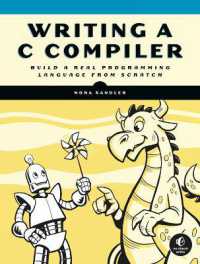Full Description
The Neurobiology, Physiology and Psychology of Pain focuses on bettering readers' understanding of acute and chronic pain. Featuring chapters on neurotransmitters, pharmacology, and brain imaging, this volume discusses, in detail, the mechanisms of pain and experimental studies undertaken to better understand the pathways involved. The translational work in this area has applicability for neurologists, anesthesiologists, pharmacologists, and anyone working in the intersection of these areas. This volume is integral for anyone interested in the molecular underpinnings of pain at every level.
Contents
I. Molecular and cellular aspects
1. Gene expression, KCNQ/Kv7 channels and neuropathic pain
2. The NTRK1 gene and congenital insensitivity to pain
3. Prdm12, a key transcriptional regulator of the nociceptive lineage
4. Linking the genetics of fibromyalgia and painFernando
5. Fentanyl: Polymorphisms, and adverse events
6. Propofol anesthesia and molecular changes in the brain
7. Protein Kinase G is a Molecular Switch for Pain
8. Adrenergic agonists and the mu opioid receptor
9. Inflammatory and neuropathic pain impact on the opioid function in the mesocorticolimbic systemL
10. Clinacanthus nutans, analgesia and the l-arginine/nitric oxide-mediated/cyclic-guanosine monophosphate-independent pathway
11. alpha2/3-selective GABAA receptor PAMs as pain medications
12. alpha5GABAA receptors and their role in pain perception
13. ATP sensitive potassium channels in pain and analgesia
14. Astrocyte-neuron lactate shuttle and pain
15. Nociception and sweet solutions: applications to inflammatory pain
16. Interlinking Interleukin-33 (IL-33), neuroinflammation and neuropathic pain
17. Neurons of the parabrachial nucleus, nociceptive input and pain pathways
18. Anterior cingulate cortex, pain perception and pathological neuronal plasticity during chronic pain
19. Sleep deprivation headaches and Fos immunohistochemistry
20. Antinociceptive glucagon-like peptides
21. Pain transmission and peripheral group III metabotropic glutamate receptors (mGluRs)
22. TRPM -8 receptor and menthol in pain management
II. Physiology, imaging and physical recordings
23. Anesthetic and proconvulsant effects of ketamine on EEG
24. Electroencephalography and anesthetic doses of ketamine
25. Linking heart function and analgesia
26. Computed Tomography-guided procedures for epidural injections
27. Chronic pain: Linking deep brain stimulation and sensory functional MRI
28. Neurocognition and placebo analgesia: linking in functional magnetic resonance imaging
29. Linking the cortex, functional spectroscopy and pain: features and applications
30. Muscle origins of myofascial pain syndrome
III. Psychology and Behaviour
31. Behavioral markers of pain
32. Adverse life events, sensitization of spinal nociception, and chronic pain risk
33. Cognitive-affective modulation of pain: The Placebo and nocebo phenomena and their impact on pain treatment
34. Nociception-related behavioral phenotypes in adult zebrafish
35. Pain, implantable pain devices and psychosocial aspects as a narrative
36. Influence of psychological factors in myofascial pain
IV. Resources
37. Resources








